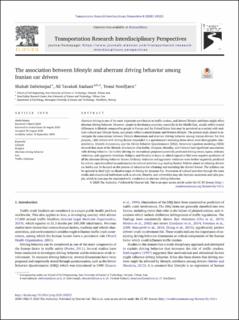| dc.description.abstract | Aberrant driving is one of the most important contributors to traffic crashes, and drivers' lifestyle attributes might affect aberrant driving behavior. However, people in developing countries, especially in the Middle East, usually reflect crucial differences in lifestyle compared to people in Europe and the United States. Iran may be perceived as a society with multiple cultural and lifestyle facets, and people reflect a mixed Islamic and Western lifestyle. The present study aimed to investigate the associations between lifestyle dimensions and aberrant driving behavior among Iranian drivers. For this purpose, 1260 drivers with driving license responded to a questionnaire including items about socio-demographic characteristics, lifestyle dimensions, and the Driver Behavior Questionnaire (DBQ). Structural equation modeling (SEM) showed that most of the lifestyle dimensions (Car hobby, Religion, Morality, and Culture) had significant associations with driving behavior. Car hobby (driving for recreational purposes) positively predicted driving errors, lapses, ordinary violations, and aggressive violations. Religion and Morality (a focus on ethical aspects in life) were negative predictors of all the aberrant driving behavior factors. Ordinary violations and aggressive violations were further negatively predicted by culture, operationalized as participation in cultural activities (e.g. reading books). Policies aimed at reducing drivers' car hobby can be focused on the process of education for obtaining and extending the driver's license. The syllabus can be updated to shed light on disadvantages of driving for pleasure/fun. Promotion of cultural activities through the mass media and educational institutions such as schools, libraries, and universities may also increase awareness and calm people, which in turn may be associated with a reduction in aberrant driving behavior. | en_US |

